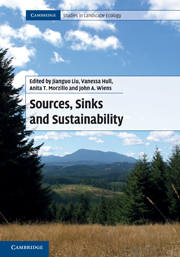Book contents
- Frontmatter
- Contents
- Contributors
- Preface
- Acknowledgments
- Part I Introduction
- Part II Advances in source–sink theory
- Part III Progress in source–sink methodology
- 9 On estimating demographic and dispersal parameters for niche and source–sink models
- 10 Source–sink status of small and large wetland fragments and growth rate of a population network
- 11 Demographic and dispersal data from anthropogenic grasslands: what should we measure?
- 12 Network analysis: a tool for studying the connectivity of source–sink systems
- 13 Sources, sinks, and model accuracy
- 14 Scale-dependence of habitat sources and sinks
- 15 Effects of experimental population removal for the spatial population ecology of the alpine butterfly, Parnassius smintheus
- Part IV Improvement of source–sink management
- Part V Synthesis
- Index
- References
15 - Effects of experimental population removal for the spatial population ecology of the alpine butterfly, Parnassius smintheus
Published online by Cambridge University Press: 05 July 2011
- Frontmatter
- Contents
- Contributors
- Preface
- Acknowledgments
- Part I Introduction
- Part II Advances in source–sink theory
- Part III Progress in source–sink methodology
- 9 On estimating demographic and dispersal parameters for niche and source–sink models
- 10 Source–sink status of small and large wetland fragments and growth rate of a population network
- 11 Demographic and dispersal data from anthropogenic grasslands: what should we measure?
- 12 Network analysis: a tool for studying the connectivity of source–sink systems
- 13 Sources, sinks, and model accuracy
- 14 Scale-dependence of habitat sources and sinks
- 15 Effects of experimental population removal for the spatial population ecology of the alpine butterfly, Parnassius smintheus
- Part IV Improvement of source–sink management
- Part V Synthesis
- Index
- References
Summary
For spatially segregated populations, the dispersal of organisms among local populations is a fundamental process affecting population dynamics and persistence. We present preliminary results from a long-term, large-scale experiment examining the effects of population removal for surrounding populations. During 2001–2006 we removed adult butterflies from two large populations within a system of 17 subpopulations of the Rocky Mountain Apollo butterfly, Parnassius smintheus. Surrounding populations were monitored using individual mark–recapture methods. We found that population removal reduced immigration into surrounding populations. Correspondingly, within-generation abundance of these populations was reduced. There was little effect of the loss of immigration for local population persistence. Only one confirmed local extinction occurred during the removals, but it was in a population expected to be highly impacted by the removals. Populations experiencing apparent local extinctions (observation of no adults within a flight season), and thus evidence of extremely low abundance, were much less connected than populations that did not experience such low abundances. Taken together, these results point to a system where immigration is too infrequent to impact the persistence of most populations, but may be frequent enough to recolonize or rescue the smallest populations from extinction. Given the fragmentation of these meadows, due to forest encroachment, the results imply that the persistence of this system will be more greatly impacted by the loss of habitat than by the isolation of populations, provided that some large populations remain.
- Type
- Chapter
- Information
- Sources, Sinks and Sustainability , pp. 317 - 334Publisher: Cambridge University PressPrint publication year: 2011

